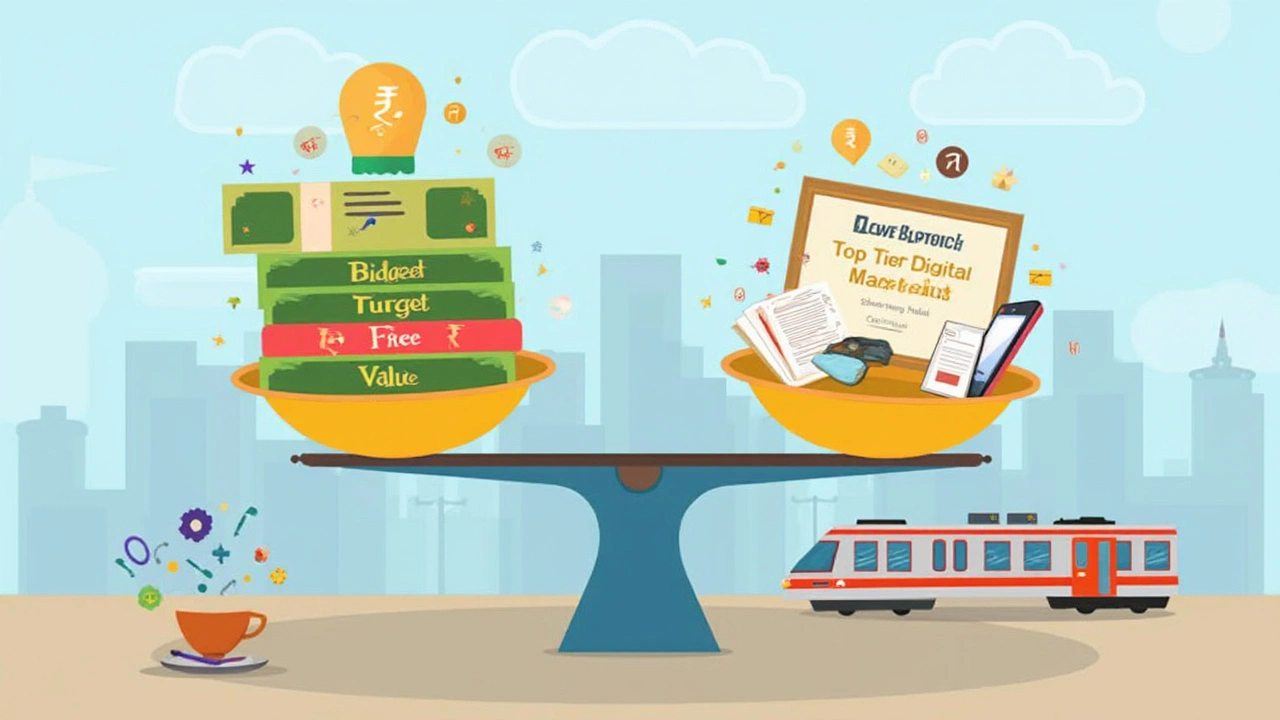Digital marketing courses aren’t one-price-fits-all. You’ll find options that are totally free, some that cost less than a night out, and others that can burn a serious hole in your wallet. The money question isn’t just about the number you see on the website—there’s usually more going on beneath the surface.
Maybe you’re looking to switch careers fast, or just want to boost your skills without emptying your savings. It helps to know exactly what you’re paying for, what’s just a shiny label, and what’s actually going to help you land a job or promotion. Don’t be fooled by high price tags—but also don’t expect a ₹999 course to give you the keys to the digital kingdom.
Before you type your card details on any site, figure out what you need, what you’ll actually use, and what’s just hype. Prices swing so much because of who’s teaching, what you get (is there help with finding a job? Real-world projects, or just theory?), and how deep the course goes. It’s the reality check most people miss until they’ve already paid up.
- Why Are Digital Marketing Course Prices All Over the Place?
- Online vs. Classroom: Where Does Your Money Go?
- Are Free Courses Ever Worth It?
- Extras and Hidden Costs You Might Miss
- How to Pick a Course That’s Worth Every Rupee
Why Are Digital Marketing Course Prices All Over the Place?
This industry is a wild mix of options—some digital marketing courses are almost free, while others feel like a major investment. There’s actually a reason for all this chaos: different courses offer different things, with a huge range in quality and results.
First, who’s running the course makes a huge difference. If you compare a neighborhood coaching center with a top name like Google or Meta, the brand alone adds a premium. It’s just how the market works. Also, universities and big edtech companies like Coursera or UpGrad add extra costs for their certifications and global credibility.
Next, depth and length matter. A 2-hour crash course that covers basics can’t cost the same as a three-month program with mentorship, live classes, and placement help. Here’s a quick look at the typical range in India as of mid-2025:
| Type | Provider Example | Cost (INR) | Duration |
|---|---|---|---|
| Short Self-paced Online | Udemy, Skillshare | 700 - 5,000 | 2-10 hours |
| Certified Online Program | Coursera, Google, Facebook | 7,000 - 35,000 | 6-16 weeks |
| Full-length Diploma | UpGrad, NIIT, Simplilearn | 35,000 - 1,25,000 | 3-12 months |
| In-person Classroom | Local Institutes, Colleges | 15,000 - 2,50,000 | 1-12 months |
One more thing: look at the extras. Does the course include live classes, one-on-one mentoring, job placement help, or real-life project experience? These things quickly inflate the price. Courses with a direct line to hiring partners, big brands, or who actually offer support after you finish (like resume reviews or interview prep) tend to charge more.
But don’t get blinded by branding or big claims. Sometimes, a solid digital marketing course from a lesser-known provider gives you the tools without the huge price. The key is to match the offering to what you actually want to do with your skills. If you’re after a job at a major MNC, the fancy certificate might help. If you’re freelancing or launching your own gig, hands-on, affordable learning might be all you need.
Online vs. Classroom: Where Does Your Money Go?
Not all digital marketing courses cost the same, and a big reason is their format. Online courses and in-person classes have different ways of doing things, which really affects what you pay for—and what you actually get.
Let’s break it down:
- Online courses usually charge less. Why? No classrooms, no fancy buildings, no printed handbooks, and there’s often one teacher delivering lessons to thousands of students at once. Recorded lectures can be watched anytime—handy if you’re working or have a weird schedule. Top platforms like Coursera and Udemy list digital marketing basics courses starting as low as ₹500-₹2500. Some certified online programs, like those from Google Digital Garage, are even free.
- Classroom (offline) courses usually cost more. Expect fees between ₹30,000 to over ₹1 lakh for well-known academies in cities like Bangalore or Mumbai. Your money covers on-site materials, full-time trainers, air-conditioned classrooms, and sometimes even lunch. Face-to-face networking and one-on-one support can be a big deal if you struggle to stick to online learning or want hands-on experience.
Here’s a quick comparison so you can see where your money goes:
| Type | Typical Fees | What You Usually Get | Flexibility |
|---|---|---|---|
| Online | ₹500 – ₹25,000 | Recorded/video lessons, self-paced study, online forums, sometimes live webinars | High (study anytime) |
| Classroom | ₹30,000 – ₹1,20,000 | Face-to-face classes, printed materials, live projects, peer group network, trainer interaction | Low (fixed schedule) |
Some people spend extra for hybrid programs (part online, part in-person), which can land somewhere in the middle for both cost and commitment. The takeaway? Don’t just compare price tags. Think about your learning style, your time, and what kind of support actually helps you. The cheapest option isn’t always the best, and the most expensive doesn’t guarantee success either.
The digital marketing course you choose should match your goals and budget, not just look good on Instagram. Ask for a real syllabus, check if you get help with job placements, and always try a free trial or demo if you can.

Are Free Courses Ever Worth It?
Scrolling through the web, you've probably spotted loads of free digital marketing courses. Names like Google Digital Garage, HubSpot Academy, and Facebook Blueprint pop up first. These aren’t scams—giants like Google and HubSpot really do give away pretty high-quality basics, and millions have signed up. But here's the thing: free doesn’t always mean “complete.”
Free courses can be a great way to get your feet wet. If you’re just exploring, want to add a certification line to your LinkedIn, or looking for quick answers (how does SEO work? what's a Facebook ad campaign?), they absolutely deliver. For a lot of folks, it’s enough to get started, figure out what they actually want to do, and maybe even help with small projects or interviews.
But how far can they really take you? Check out this comparison of what free vs. paid digital marketing courses usually offer:
| Key Feature | Free Course (e.g., Google, HubSpot) | Paid Course |
|---|---|---|
| Practical Projects | Basic level (often generic) | Real industry examples, hands-on assignments |
| Certification | Yes, but not always recognized by employers | Recognized, sometimes partnered with industry players |
| Mentor Support | Almost never | Direct feedback, 1:1 sessions |
| Career Support | None | Resume help, job leads, interview prep |
| Depth of Content | Surface-level, broad topic overviews | Deep dives, advanced modules, current trends |
Another thing—some recruiters still look for practical skills. Free courses might teach you what SEO means, but they rarely give actual project experience. One tip: if you take a free course, try to apply what you learn right away. Start a blog, run a tiny social campaign, or offer free help to a local business. When you show work, you stand out.
Some free digital marketing courses have quizzes and digital badges, but don’t expect big companies to be super impressed. Still, Google’s free certification is known and won’t hurt your profile. HubSpot has helped tons of folks land interviews, even if it’s just as a door-opener.
Bottom line? If money’s tight or you’re just exploring, hit the free resources first. But if you’re serious about landing roles, want mentorship, or need recognized certification, investing in a solid digital marketing course pays off in the long run. Learn for free—practice even more—and then decide if you’re ready to spend.
Extras and Hidden Costs You Might Miss
You see a price on a digital marketing course, but what about the stuff nobody talks about up front? Turns out, there can be a lot of “gotchas” that make the real price way higher than what first shows up on the website.
Here’s what a lot of people don’t realize until they get the bill or try to access all the content:
- Software Subscriptions: Some courses require you to use paid tools like SEMrush, HubSpot, or Adobe Creative Cloud. These can cost anywhere from ₹1,500 to ₹7,000 per month—sometimes even more.
- Certification Fees: A lot of programs charge an extra ₹1,000 to ₹15,000 if you want an official certificate at the end. Don’t assume the paper is included.
- Project/Assignment Fees: Some premium courses ask for extra payment if you want your assignments personally reviewed by a mentor or industry expert.
- Extra Modules: That basic package might look cheap, but if you want any advanced content or “specializations,” expect to pay a surcharge.
- Workshop and Placement Support: Career services, such as resume writing workshops or placement assistance, often cost extra—sometimes up to ₹10,000 depending on the platform.
Now, let’s make it easier to see. Here’s a quick comparison of possible hidden costs you might run into:
| Hidden Cost Type | Average Fee (INR) | Common With |
|---|---|---|
| Software Tools | ₹1,500 - ₹7,000/month | Project-based courses |
| Official Certification | ₹1,000 - ₹15,000 | Most established platforms |
| Mentorship/Project Review | ₹2,000 - ₹9,000 | Premium and live courses |
| Advanced Content Modules | ₹3,000 - ₹12,000 | Tiered learning platforms |
| Career Support | ₹2,000 - ₹10,000 | Courses with job guarantee |
If you’re tight on budget or just hate surprises, always check the FAQ or terms and conditions before you pay. If something sounds too cheap to be true, there’s a good chance you’ll hit a paywall for features every real marketer needs. Reach out to support and ask for a total cost breakdown—if they dodge your questions or give vague answers, it’s a red flag.

How to Pick a Course That’s Worth Every Rupee
Choosing the right digital marketing course can make or break your learning experience, so don’t just jump at the first trend you see. The best course gives you skills you’ll actually use, and helps you stand out if you’re hunting for a job or promotion. Here’s what you should look out for before spending your hard-earned cash.
- Check the Trainer’s Experience: Google their name, see what they’ve done in digital marketing, and check LinkedIn for any real campaigns or past students talking about them. Big brand trainers or agencies backing the course? Huge plus.
- What Do You Really Get? Look for details about live projects, hands-on assignments, one-on-one mentoring, real-world case studies, and placement support. If it’s just a bunch of pre-recorded videos and no feedback, it’s not likely to be worth much.
- Certification Quality: Will you get a certificate that’s actually recognized by top employers (like Google, Meta, or HubSpot)? Some Indian institutes partner with these giants, which can be a deal-maker for your resume.
- Student Reviews: Real reviews that mention both good and bad points can save you from scams and hyped-up courses. Head to Reddit, Quora, or even Instagram to see what past students say.
- Support and Community: Can you talk to teachers if you get stuck? Is there an active group or alumni community? This stuff matters a lot when you actually start applying what you learn.
Here’s a quick table to help compare what you get at different price points:
| Course Type | Price Range | Duration | Support | Placement Help | Certification |
|---|---|---|---|---|---|
| Free Course | ₹0 – ₹1,500 | Self-paced | None | No | Limited/None |
| Entry-Level (Online) | ₹2,000 – ₹10,000 | 1–3 months | Email/Forum | No | Often not recognized |
| Pro/Brand-Partnered | ₹18,000 – ₹90,000 | 3–6 months | Live, Assignments, Mentoring | Yes | Google/Meta/Well-Known |
| MBA/Advanced Classroom | ₹1,00,000+ | 1–2 years | Full, Career Services | Strong | Globally Recognized |
Before paying, ask for a detailed syllabus (not just a list of buzzwords), and check if you’ll actually get to create ads, manage live budgets, or analyze real campaigns. Most genuine trainers offer sample lessons or even free trials—a good sign they actually want you to learn, not just pay up front.
Avoid courses that over-hype “guaranteed jobs” unless you can verify their placement stats. If possible, DM a couple of alumni on LinkedIn and ask if the course actually helped them land their role. Spending extra for a solid program can give you connections and skills money can’t buy—but never pay for style over substance.
